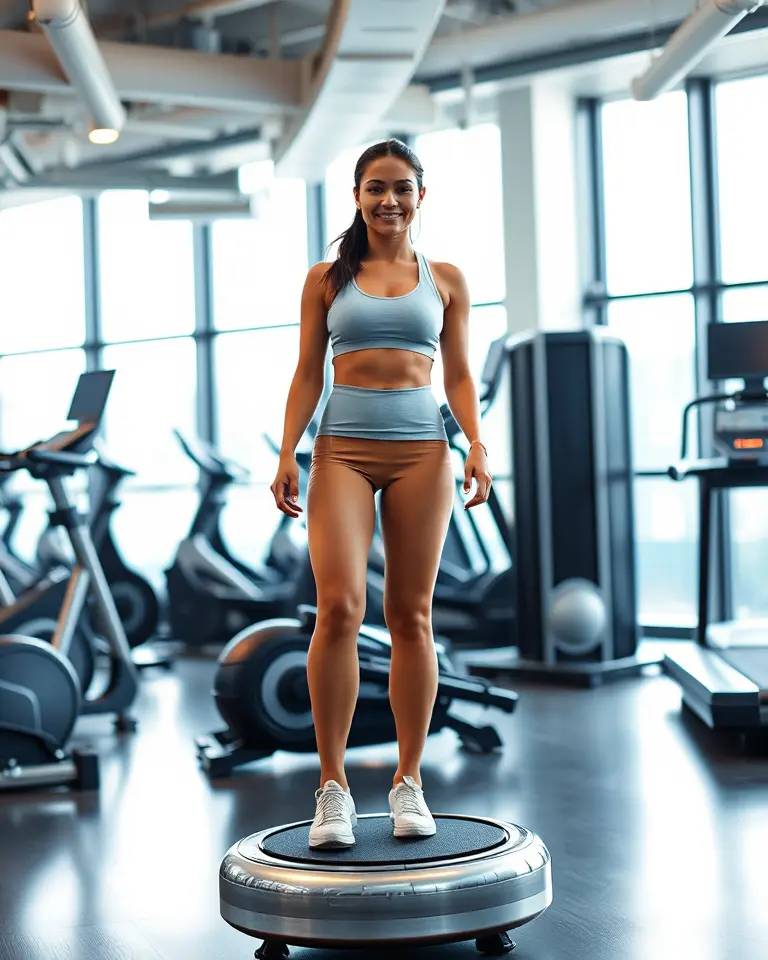Vibration plates have surged in popularity, becoming a common sight in gyms and homes. These platforms, which vibrate at high speeds, are purported to offer a range of benefits, from weight loss and muscle gain to improved balance and circulation. But are they genuinely effective, or just another fitness fad? This article delves into the science behind vibration plates, exploring their potential benefits, risks, and how to use them safely.
What are Vibration Plates?
Vibration plates, also known as power plates or vibrating platforms, are fitness devices that use whole-body vibration to stimulate muscles. These machines feature a platform that vibrates rapidly, usually between 20 to 60 times per second. When you stand, sit, or perform exercises on the plate, these vibrations cause your muscles to contract and relax involuntarily. This constant muscle activation is believed to be the key to the purported benefits of vibration plate training.
How Do Vibration Plates Work?
The core principle behind vibration plates is the concept of whole-body vibration (WBV). The rapid oscillations of the platform transmit energy to your body, forcing your muscles to work harder to maintain stability. This is achieved by stimulating muscle fibers at a much higher rate than normal. Normally, muscles contract and relax once or twice a second, but a vibration plate can significantly increase this rate. This increased muscle activation is thought to enhance the effectiveness of exercises performed on the plate. The intensity of the workout can be adjusted by changing the frequency and amplitude of the vibrations, allowing users to customize their training experience.
Potential Benefits of Vibration Plates
While the research is still ongoing, several potential benefits of vibration plate training have been identified:
Muscle Strength and Growth
Vibration plates can be a great tool for building muscle strength. The rapid vibrations cause muscles to contract and relax more frequently than during regular exercise. This constant stimulation can lead to increased muscle mass and strength over time. Some studies have found that vibration training is effective for various groups, including older adults and athletes. It is also a low-impact alternative to weight training, making it suitable for people who want to strengthen their muscles without putting excessive stress on their bodies.
Weight Loss and Fat Reduction
There is promising evidence that vibration plates can aid in weight loss. The increased muscle activity burns more calories, and some studies suggest that vibration plates can help reduce both overall body fat and abdominal fat. One study showed that using vibration plates can lead to a large amount of fat loss. Additionally, the increase in muscle mass can boost metabolism, which further helps with weight management when combined with a healthy diet. It’s important to note that while vibration plates might help with weight loss, they are most effective when used in conjunction with regular cardio exercise and a balanced diet.
Improved Balance and Stability
The unstable surface of a vibrating plate challenges your balance, which activates your neuromuscular system. This system, encompassing muscles and nerves, plays a crucial role in coordination and movement. Through regular use, vibration plates may improve balance, stability, and overall movement. Research has shown that older adults, in particular, experience enhanced sit-to-stand performance after vibration plate training, likely due to improved muscle function and proprioception (your body’s awareness of its position).
Reduced Back Pain
Studies have shown that vibration plate training can reduce lower back pain. This effect is attributed to several factors. First, the vibrations activate muscle fibers in the trunk, improving muscle strength. Second, they help relax lower back muscles, relieving pain. Finally, they activate proprioceptors, which helps in aligning the body, improving back stability.
Enhanced Circulation
The vibrations from the plate promote blood flow, which enhances the delivery of nutrients and oxygen to cells throughout the body. This improved circulation can help reduce post-exercise muscle soreness, improve recovery, and support overall functioning.
Cognitive Function
Some research suggests that vibration plate training can improve cognitive skills. Studies indicate that vibration training can boost thinking skills in both healthy individuals and those with cognitive problems. However, the way you stand on the plate can influence the transmission of vibrations to your head.
Bone Density
Vibration plates can also help boost bone mass. This is especially beneficial for older adults, as it can help to reduce the risk of osteoporosis and fractures.
How to Use a Vibration Plate
Using a vibration plate correctly is essential for safety and effectiveness. Here is a step-by-step guide:
- Setup: Place the vibration plate on a flat, stable surface in a space that allows for comfortable movement.
- Starting Position: Step onto the plate with your feet shoulder-width apart and your knees slightly bent. If your plate has handles, grasp them securely.
- Adjustment: Turn on the machine and adjust the settings to your desired intensity, starting with a low setting.
- Adaptation: Allow your body 30-45 seconds to adjust to the vibrations.
- Exercises: Begin your chosen exercises, ensuring you feel stable and comfortable.
- Duration: Most vibration plate workouts last for around 15-20 minutes.
Basic Vibration Plate Exercises
- Squats: Stand with feet hip-width apart, lower your hips as if sitting in a chair.
- Push-ups: Place hands on the vibration plate, lower your body towards the plate.
- Plank: Position forearms on the plate, maintain a straight line from head to heels.
- Lunges: Step one foot onto the plate, lower into a lunge position.
- Calf Raises: Stand with feet flat on the plate, raise up onto your toes.
- Step-ups: Face the vibration plate and step up onto the plate.
- Heel and Toe Raises: Stand with feet flat on the plate and raise onto your toes, and then heels, alternating.
Other exercises include abdominal exercises like crunches, and modified mountain climbers.
Potential Risks and Side Effects
While generally considered safe, there are potential risks associated with vibration plates, especially when used improperly.
Safety Precautions
- Consult Your Doctor: Always consult a healthcare professional before using a vibration plate, especially if you are pregnant, older, have a pre-existing medical condition, or have recently had surgery.
- Start Slowly: Begin with low settings and gradually increase the intensity as your body adapts.
- Maintain Proper Form: Ensure you maintain good form during exercises to prevent injuries.
- Listen to Your Body: Stop immediately if you experience any discomfort, pain, or dizziness.
Potential Side Effects
- Dizziness and Nausea: Some people may experience dizziness or nausea, especially during their first few sessions. This is due to the stimulation of the vestibular system (the body’s balance system) and typically subsides once you stop.
- Muscle Soreness: It is not unusual to experience muscle soreness after using a vibration plate.
- Low Back Pain: While some studies indicate a reduction in back pain, vibration exposure has been linked to an increased risk of low back pain in some cases.
- Headaches and Neck Pain: Some users may experience headaches and neck pain.
- Risk of Injury: Using a vibration plate with poor form may increase the risk of muscle or bone injuries.
- Interference with Medical Implants: Individuals with medical implants, such as pacemakers, should consult their doctor before using a vibration plate, as the vibrations can potentially interfere with the functioning of these devices.
- Other Conditions: Other potential side effects include motion sickness, digestive problems, nervous system damage, cardiovascular disease, and even an increased risk of cancer.
Who Should Avoid Vibration Plates?
Vibration plates may not be suitable for everyone. Individuals with the following conditions should exercise caution:
- Recent Injuries: People with recent muscle or bone injuries should avoid vibration plates, as the vibrations could slow down the recovery process.
- Medical Implants: Those with pacemakers or other electronic medical devices should consult their healthcare provider due to the risk of interference.
- Pregnancy: Pregnant women should avoid using vibration plates.
- Balance and Coordination Issues: Individuals with balance and coordination problems may be at an increased risk of falls while using a vibration plate.
- Osteoporosis: While some research indicates that vibration plates can reduce bone loss, the vibrations could cause bone fractures at higher intensities.
The Verdict: Are Vibration Plates Worth the Hype?
Vibration plates can be a valuable addition to a fitness routine. They offer a variety of potential benefits, including muscle strengthening, weight loss, improved balance, and reduced back pain. However, they are not a magic bullet and should not replace regular exercise and a healthy diet. Like all fitness tools, it is important to use them correctly and be aware of the potential risks. If you are considering incorporating a vibration plate into your fitness routine, consult your doctor, start slowly, and pay attention to your body. With proper usage, vibration plates can be an effective tool for enhancing your overall fitness and wellness.
While more research is still needed to fully understand the long-term effects of vibration plates, the current evidence suggests that they can be a useful tool when used correctly and in conjunction with other health and fitness practices. They are best used as a supplement to, not a replacement for, a balanced fitness regimen.







